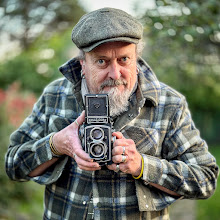 |
Brewhouse Quay; the strong graphic quality means
that colour would add little if anything. Red and yellow
channels were lightened a little during B&W
conversion to add mid tone contrast to replicate how
B&W film would record such a scene.
CLICK TO ENLARGE! |
If you look on model railway internet forums it's common to see dull flat photos of toy chuffers in black and white. Apparently to many forum-flies, many layouts and modelling 'look more realistic', but hits on my website when I publish both colour and B&W of the same photo would tend to suggest that colour always wins on the 'hit' front by around 2 to 1.
I think much of the time why modellers prefer B&W to colour is because their white balance is so far out, so converting that shot to monochrome gets around that issue. We've all done it I'm sure, especially if trying to shoot something at a show with all the mixed lighting casting different colours on everything, or if you're a bloke, simply not reading those new camera instructions to work out how to set the white balance!
Tip: shoot RAW and write your white balance later at home if your camera allows!
Very occasionally I do get that shot which gets more B&W hits than colour, this is probably something to do with the lighting and composition. Those shots tend to have a strong graphic quality, any colour adding little or no value. Luckily these lazy days we can make that choice in the virtual darkroom at a later stage. But if shooting a B&W shot specifically, it's always good to 'see' in B&W at the taking stage, concentrating on those aspects that make a B&W shot work by ignoring the colour aspect. Google Colin Gifford or Bill Brandt and you'll see what I mean.
 |
Tide out at Le Touquet - originally a colour shot, but the
blue channels darkened and yellow channels lightened during
B&W conversion to replicate the effect of B&W film shot
through a red filter. CLICK TO ENLARGE! |
Many think that turning a digital colour photo into B&W is simply a matter of converting the image to 'greyscale'; of course you do get a B&W image, but it will often look muddy, lack contrast and the tone separation between what were originally the coloured areas like duotone carriage liveries (especially 'blood and custard'). This is because B&W film, even though it is monochrome does see colour and records it differently to a simple grey scale conversion. In the days of B&W film, photographers would exploit this aspect further by adding coloured filters to their camera lenses to produce differing effects.
The most popular filter was yellow, the yellow filter brightening yellows and green in a landscape (or the yellow end to a loco) and darkening the blues, great for a summer days when wanting to separate the fluffy white clouds from the blue sky. For more extreme effects orange or even red filters could be used, red in particular darkening the blue sky to almost black and lightening the yellow/red end of the spectrum to make these colours appear white in monochrome. For railway photographers this could give the most most bazaar effect to a BR Blue loco on a sunny summer day!
 |
A Midland 3F on Catcott Burtle, originally in colour, as before
the yellow and red channels were lightened a tad and the
blue channel darkened a bit at the B&W conversion
stage. The effect is similar to what you'd get shooting outside
on a summer's day with a yellow filter on the camera lens
when using B&W film. A simple grey scale conversion of the
colour photo would be lacking in contrast in the grass and
sky, yellows and reds in particular becoming far too dark and
muddy during a straight greyscale conversion.
CLICK TO ENLARGE! |
In the wacky world of digital, you can do much of the above with your editing software by adjusting the colour intensities when B&W converting. I'm not going to tell you how here, but have a quick Google on the subject and try for yourself, you'll never be satisfied with a simple grey scale conversion ever again and may even get that rare shot that's more popular in B&W than colour.
To celebrate B&W in miniature, I have created a Flickr collection of some of my favourite B&W shots -
they can be found here.





Thank you so much for posting this! I hope that everyone who tries B&W conversions reads this!
ReplyDeleteI find shots taken at the NEC look better in black and white, but then the light does provide an automatic strong yellow cast anyway.
ReplyDelete